Kawai ES5, ES3 User Manual

DIGITAL PIANO
ES3/ES5
OWNER’S MANUAL
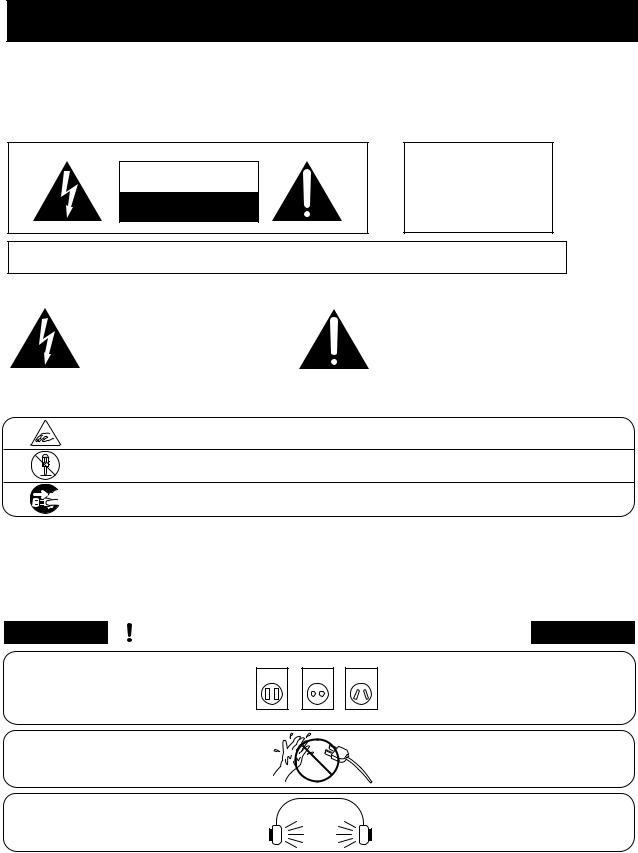
Important Safety Instructions
SAVE THESE INSTRUCTIONS
INSTRUCTIONS PERTAINING TO A RISK OF FIRE, ELECTRIC SHOCK, OR INJURY TO PERSONS
CAUTION |
RISK OF ELECTRIC SHOCK |
DO NOT OPEN |
WARNING
TO REDUCE THE RISK OF FIRE OR ELECTRIC SHOCK, DO NOT EXPOSE THIS PRODUCT TO RAIN OR MOISTURE.
AVIS : RISQUE DE CHOC ELECTRIQUE - NE PAS OUVRIR.
TO REDUCE THE RISK OF ELECTRIC SHOCK, DO NOT REMOVE COVER (OR BACK).
NO USER-SERVICEABLE PARTS INSIDE. REFER SERVICING TO QUALIFIED SERVICE PERSONNEL.
The lighting flash with arrowhead symbol, within an equilateral triangle, is intended to alert the user to the presence of uninsulated "dangerous voltage" within the product's enclosure that may be of sufficient magnitude to constitute a risk of electric shock to persons.
The exclamation point within an equilateral triangle is intended to alert the user to the presence of important operating and maintenance (servicing) instructions in the leterature accompanying the product.
Examples of Picture Symbols
denotes that care should be taken.
The example instructs the user to take care not to allow fingers to be trapped.
denotes a prohibited operation.
The example instructs that disassembly of the product is prohibited.
denotes an operation that should be carried out.
The example instructs the user to remove the power cord plug from the AC outlet.
Read all the instructions before using the product.
WARNING - When using electric products, basic precautions should always be followed, including the following.
 WARNING Indicates a potential hazard that could result in death or serious injury if the product is handled incorrectly.
WARNING Indicates a potential hazard that could result in death or serious injury if the product is handled incorrectly.
The product should be connected to |
|
|
|
● Use the AC adapter supplied with the product |
an AC outlet of the specified |
120V |
230V |
240V |
or one recommended by Kawai. |
● If you are going to use an AC power cord, |
||||
voltage. |
|
|
|
make sure that its has the correct plug shape |
|
|
|
|
and conforms to the specified power voltage. ● Failure to do so may result in fire.
Do not insert or disconnect the power cord plug with wet hands.
When using the headphones, do not listen for long periods of
time at high volume levels.
Doing so may cause electric shock.
Doing so may result in hearing problems.
– 2 –
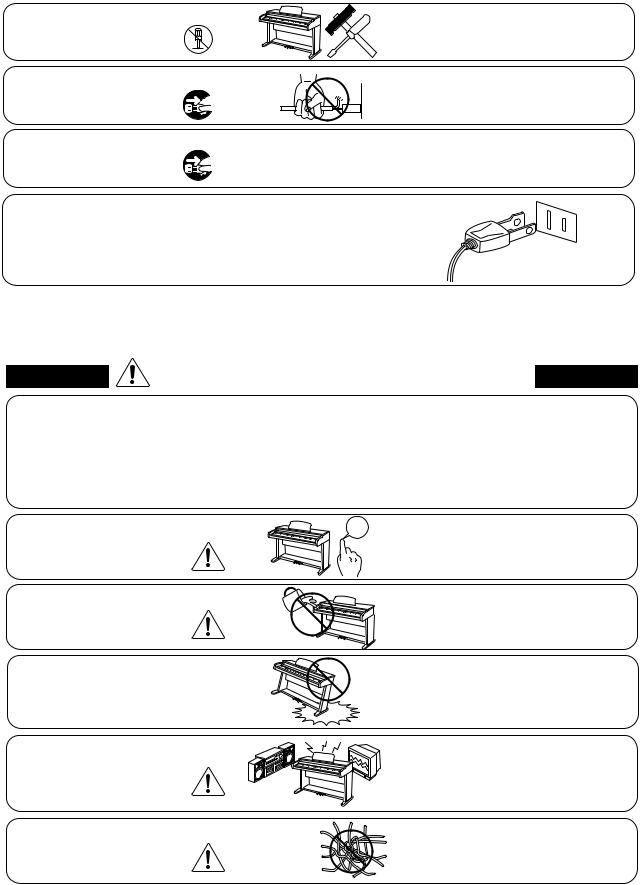
Do not disassemble, repair or modify the product.
When disconnecting the AC power cord's plug, always hold the plug
and pull it to remove it.
If the product will not be used for a long time, unplug the AC power
cord from the AC outlet.
Doing so may result in product breakdown, electric shock or short-circuit.
●Pulling the AC power cord itself may damage the cord, causing a fire, electric shock or short-circuit.
●Failure to do so may cause fire in case of lightning.
●Failure to do so may over-heat the product, resulting in fire.
This product may be equipped with a polarized line plug (one blade wider than the other). This is a safety feature.
If you are unable to insert the plug into the outlet, contact an electrician to replace your obsolete outlet.
Do not defeat the safety purpose of the plug.
Indicates a potential hazard that could result in injury
CAUTION or damage to the product or other
Do not use the product in the following areas.
●Areas, such as those near windows, where the product is exposed to direct sunlight
●Extremely hot areas, such as near a heater
●Extremely cold areas, such as outside
●Extremely humid areas
●Areas where a large amount of sand or dust is present
●Areas where the product is exposed to excessive vibrations
Using the product in such areas may result in product breakdown.
Before connecting cords, make sure |
OFF |
Failure to do so may cause breakdown of this |
that the power to this product |
|
product and other devices. |
and other devices is turned |
|
|
OFF. |
|
|
Take care not to allow any foreign matter to enter the product.
Do not drag the product on the floor. Take care not to drop the product.
Do not place the product near electrical appliances such as TVs and
radios.
When connecting the AC power cord and other cords, take care
not to get them tangled.
Entry of water, needles or hair pins may result in breakdown or short-circuit.
Please lift up the product when moving it. Please note that the product is heavy and must be carried by more than two persons. Dropping the product may result in breakdown.
● Doing so may cause the product to generate noise.
● If the product generates noise, move the product sufficiently away from the electrical appliance or connect it to another AC outlet.
Failure to do so may damage them, resulting in  fire, electric shock or short-circuit.
fire, electric shock or short-circuit.
– 3 –
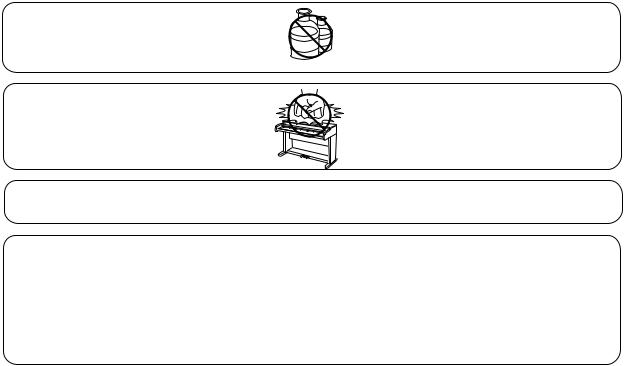
Do not wipe the product with benzene or thinner.
Do not stand on the product or exert excessive force.
●Doing so may result in discoloration or deformation of the product.
●When cleaning the product, put a soft cloth in lukewarm water, squeeze it well, then wipe the product.
●Doing so may cause the product to become deformed or fall over, resulting in breakdown or injury.
The product should be located so that its location or position does not interfere with its proper ventilation.
The product should be serviced by qualified service personnel when:
●The power supply cord or the plug has been damaged.
●Objects have fallen, or liquid has been spilled into the product.
●The product has been exposed to rain.
●The product does not appear to operate normally or exhibits a marked change in performance.
●The product has been dropped, or the enclosure damaged.
Notes on Repair
Should an abnormality occur in the product, immediately turn the power OFF, disconnect the power cord plug, and then contact the shop from which the product was purchased.
•This digital piano is for household use and is not intended for commercial use.
CAUTION:
To prevent electric shock, match wide blade of plug to wide slot, fully insert.
ATTENTION:
Pour éviter les chocs électriques, introduire la lame la plus large de la fiche dans la borne correspondante de la prise et pousser jusqu'au fond.
Instruction for AC power cord (U.K.)
Do not plug either terminal of the power cord to the ground of the AC outlet on the wall.
FCC Information
This equipment has been tested and found to comply with the limits for a Class B digital device, pursuant to Part 15 of the FCC Rules. These limits are designed to provide reasonable protection against harmful interference in a residential installation. This equipment generates, uses and can radiate radio frequency energy and, if not installed and used in accordance with the instructions, may cause harmful interference to radio communications.
If this equipment does cause harmful interference to radio or television reception, which can be determined by turning the equipment off and on, the user is encouraged to try to correct the interference by one or more of the following measures:
•Reorient or relocate the receiving antenna.
•Increase the separation between the equipment and receiver.
•Connect the equipment into an outlet on a different electrical circuit from the receiver.
•Consult the dealer or an experienced radio/TV technician for help.
Canadian Radio Interference Regulations
This instrument complies with the limits for a class B digital apparatus, pursuant to the Radio Interference Regulations, C.R.C., c. 1374.
– 4 –
Thank you for choosing this Kawai ES3/5 Digital Piano.
Your new ES3/5 is a high-quality instrument offering the very latest in leading-edge music technology. This manual contains valuable information that will help you make full use of your ES3/5’s many capabilities. Please read it carefully and keep it handy for further reference.
TABLE OF CONTENTS
Page Assembling The Stand (ES5 only) . . . . . . . . . . . . . . . . . . . . . . . . . . . . . . 6 Part Names . . . . . . . . . . . . . . . . . . . . . . . . . . . . . . . . . . . . . . . . . . . . . . . . 8 Getting Started
1. Basic Operations . . . . . . . . . . . . . . . . . . . . . . . . . . . . . . . . . . . 12 2. Transpose . . . . . . . . . . . . . . . . . . . . . . . . . . . . . . . . . . . . . . . . 14 3. Touch Response . . . . . . . . . . . . . . . . . . . . . . . . . . . . . . . . . . . 14 4. Registration . . . . . . . . . . . . . . . . . . . . . . . . . . . . . . . . . . . . . . . 15
Digital Recording Functions
1. Easy Recording . . . . . . . . . . . . . . . . . . . . . . . . . . . . . . . . . . . . 16
2. Playing Back A Song . . . . . . . . . . . . . . . . . . . . . . . . . . . . . . . 17
3. Advanced Recording/Playback Functions . . . . . . . . . . . . . . . 17
4. Deleting A Song/Track . . . . . . . . . . . . . . . . . . . . . . . . . . . . . . 18
Function Mode
1. Brilliance . . . . . . . . . . . . . . . . . . . . . . . . . . . . . . . . . . . . . . . . 20 2. Tuning . . . . . . . . . . . . . . . . . . . . . . . . . . . . . . . . . . . . . . . . . . . 20 3. Voicing . . . . . . . . . . . . . . . . . . . . . . . . . . . . . . . . . . . . . . . . . . 21 4. Sympathetic Resonance . . . . . . . . . . . . . . . . . . . . . . . . . . . . . 21 5. Temperament . . . . . . . . . . . . . . . . . . . . . . . . . . . . . . . . . . . . . 22 6. Memory Backup . . . . . . . . . . . . . . . . . . . . . . . . . . . . . . . . . . . 24 7. Lower Octave Shift . . . . . . . . . . . . . . . . . . . . . . . . . . . . . . . . . 24 8. MIDI Channel . . . . . . . . . . . . . . . . . . . . . . . . . . . . . . . . . . . . . 24 9. Transmitting Program Change Number . . . . . . . . . . . . . . . . . 24 10. MIDI Local Control On/Off . . . . . . . . . . . . . . . . . . . . . . . . . 25 11. Transmit Program Change On/Off . . . . . . . . . . . . . . . . . . . . 25 12. Turning Multi-Timbral mode On/Off . . . . . . . . . . . . . . . . . . 25 13. Channel Mute . . . . . . . . . . . . . . . . . . . . . . . . . . . . . . . . . . . . 26 14. Lower Pedal On/Off . . . . . . . . . . . . . . . . . . . . . . . . . . . . . . . 26
MIDI . . . . . . . . . . . . . . . . . . . . . . . . . . . . . . . . . . . . . . . . . . . . . . . . . . 27 Program Change Number Mapping . . . . . . . . . . . . . . . . . . . . . . . . . . . . 29 Demo Song List . . . . . . . . . . . . . . . . . . . . . . . . . . . . . . . . . . . . . . . . . . . 30 Rhythm List (ES5 only) . . . . . . . . . . . . . . . . . . . . . . . . . . . . . . . . . . . . . 30 Drum Sound Mapping (ES5 only) . . . . . . . . . . . . . . . . . . . . . . . . . . . . . 31 Specifications . . . . . . . . . . . . . . . . . . . . . . . . . . . . . . . . . . . . . . . . . . . . . 32 MIDI Implementation Chart . . . . . . . . . . . . . . . . . . . . . . . . . . . . . . . . . . 33
– 5 –
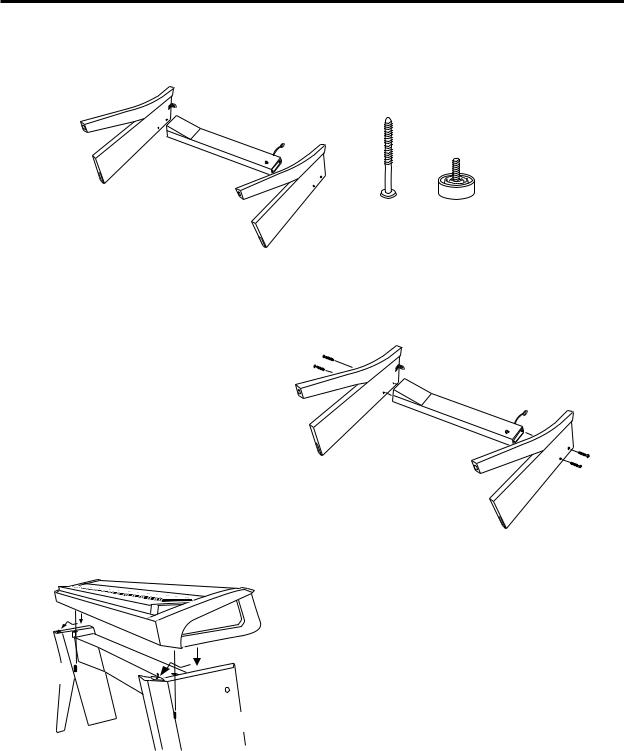
ASSEMBLING THE STAND (ES5 ONLY)
Before beginning the assembly of your ES5, read and become familiar with the assembly instructions that follow. Then, carefully unpack the piano and check your unit against the parts shown below.
Speaker Box
Stand (Left)
Stand (Right) |
Screw (Long) |
Screw (Short) |
|
x 4 |
x 2 |
1. Fasten the stands and the speaker box with four screws (long). The metal brackets on the top of the stand should face inside.
Screw (Long)
Speaker Box
Stand (Left)
Screw (Long)
Stand (Right)
Screw (Short) 
 Screw (Short)
Screw (Short)
2. Place the piano carefully on top of the stand so that about one-third of the front top edge of the stand is exposed. Then slightly lift the front of the piano and slide it forward. Fit the pins on top of the stand into the holes on the bottom of the piano. Fasten the piano and the stand with two screws (short).
CAUTION:
Be sure to secure the piano to the stand with the screws. If you fail to do so, the piano could fall from the stand causing damage or personal injury.
– 6 –
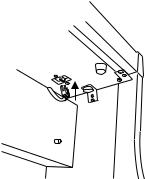
3. Insert the speaker cord that comes from the speaker box into the piano's speaker jack.
CAUTION:
Make sure to turn off the power before connecting the speaker cord.
– 7 –
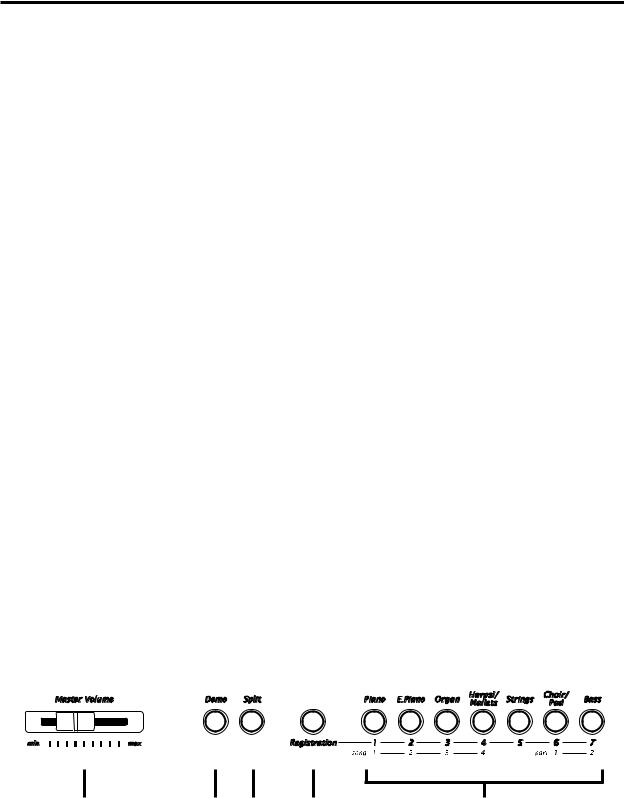
PART NAMES
Master Volume Slider (A)
Move the volume slider to the right to increase the instrument’s volume. Move the slider to the left to decrease the volume.
Demo Button (B)
Press this button to start the demo. To stop the demo, press this button again. See page 12 for details.
Split Button (C)
The split function divides the keyboard into two sections—upper and lower—and lets you play each part with a different sound. See page 13 for details.
Registration Button (D)
Use this button to memorize your favourite panel settings up to seven settings and to recall them. See page 15 for details.
Sound Buttons (E)
Select the desired instrument by pressing the appropriate button. The ES3 has three (four for ES5) sounds assigned for each Sound button. When a Sound button is pressed, the variation number is briefly shown in the display. Pressing the same Sound button again will select the next variation sound assigned to the Sound button.
FRONT PANEL
A B C D E
– 8 –

Balance/Value Buttons (F)
Normally pressing these buttons will change the current sound to the next sound or previous sound through all the preset sounds assigned to the seven Sound buttons. However, when in Dual or Split mode, these buttons work as balance adjuster for the two selected sounds. When changing settings of various functions, these buttons work as value up/down buttons. When the Metronome is running, use these buttons to change the tempo.
Effects Button (G)
Press this button to add effect. The LED indicator is lit when the effect is on. Press it again to turn the effect off. The effect type can be changed. See page 13 for details.
Reverb Button (H)
Press this button to add reverb. The LED indicator is lit when the reverb is on. Press it again to turn the reverb off. The reverb type can be changed. See page 13 for details.
Metronome (Rhythm/Metronome) Button (I)
Press this button to start metronome. Pressing again will stop metronome. The beat (time signature) can be changed. In addition, various rhythm styles can be selected for ES5. See page 16 for details.
Recorder Buttons (J)
You can record and play back up to four songs.
-Play/Stop button: Used to play back and stop a recorded song. -Rec button: Used to start recording a song.
Function Buttons (K)
Use these buttons to select a touch type, transpose the keyboard, or control other features (including MIDI functions). See page 20 for details.
F G H I J K
[ES5]
– 9 –
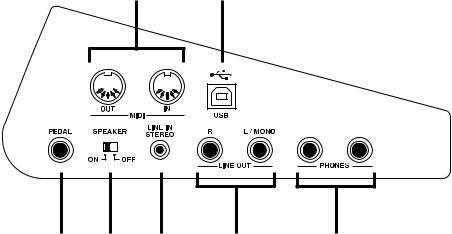
MIDI Jacks (L)
Use these jacks to connect the ES3/5 with external MIDI devices.
USB Jack (M)
This jack is used to connect with a personal computer and exchange MIDI data.
PEDAL Jack (N)
Connect the enclosed F-1r pedal to this jack. You can also connect the optional F-2r pedal (2 pedals, Damper & Soft).
SPEAKER Switch (O)
This switch turns the built-in speakers on and off.
LINE IN STEREO Jack (P)
Connect a CD player etc. with stereo mini plug.
LINE OUT Jacks (Q)
Connect an external amplifer and speakers, or a cassette recorder to these jacks.
PHONES Jacks (R)
Used to connect up to two headphones to the ES3/5.
SIDE PANEL (LEFT)
L M
N O P Q R
– 10 –
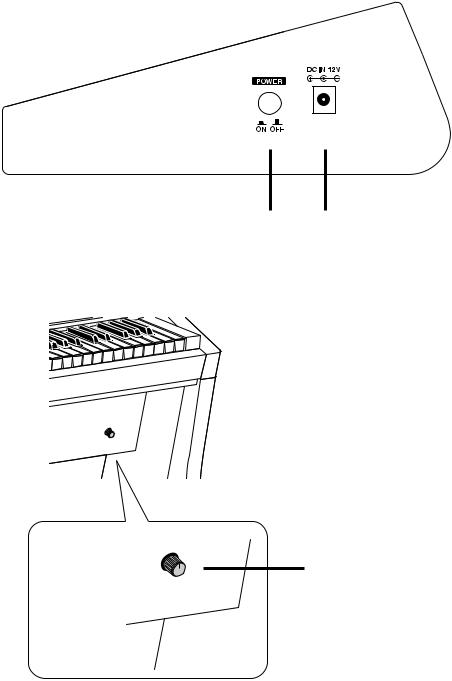
POWER Button (S)
This button turns the instrument on and off. Be sure to turn off the instrument when you are finished playing.
AC Adaptor Jack (ES3) / Power Cable Jack (ES5) (T)
Connect the enclosed AC adaptor (ES3) / Power Cable (ES5) to this jack.
Woofer Volume Knob (ES5 only) (U)
Controls the volume of the woofer speaker.
SIDE PANEL (RIGHT)
[ES3]
S T
WOOFER VOLUME
[ES5]
U
– 11 –
